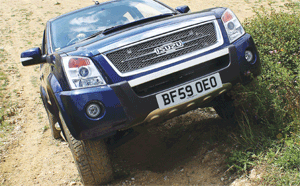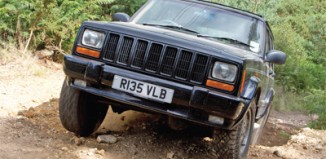Bob Cooke – contributor
 It was meant to be me giving Derek a masterclass on how to drive a moderately capable four-wheel drive over fairly serious terrain. It began with Derek putting my nose out of joint.
It was meant to be me giving Derek a masterclass on how to drive a moderately capable four-wheel drive over fairly serious terrain. It began with Derek putting my nose out of joint.
“It’ll never get up there,” I said, pointing to the steep climb up the bank at the far end of the Boxgrove Pit off-road site. “I mean it’ll make the climb, but with its long wheelbase it’ll scrape its underside as it goes over the top which might damage the exhaust or the catalyst, which we certainly don’t want to do.”
Derek has a keen sense of spatial awareness. He looked at the slope, then turned his gaze on the Rodeo pick-up and said: “It’ll get over easily.” He grinned and climbed into the Denver’s leather-and-chrome-trimmed cab, booted the Rodeo up the slope and cleared the top with centimetres to spare.
Feeling the need to wipe the smug expression off his face I said: “Okay – so what if you’d had a tonne of bricks in the back?”
“Wouldn’t have gone up.”
“Ha,” I said, warming to it: “Why not? Not enough ground clearance? Not enough power?” He shrugged: “I’d have no reason to take a tonne of bricks up there.”
I persevered. “If, like me, you weren’t sure of the clearance, you’d edge over to one side to stay out of the ruts. Have another go, keep over to the left and this time let the truck trickle up on tickover, straddling the rut.”
We’ve always been suitably impressed by the Rodeo’s 3.0-litre turbo-diesel engine, which may no longer be the most powerful in its class, but it still has seriously gutsy low-rev torque giving it excellent gently-does-it off-road ability. I could see the surprise on Derek’s face as the Rodeo chugged relentlessly up the slope on idle.
We went in search of some axle-twisting terrain next. In truth, it’s not hard to get the Isuzu pick-up cross-axled, because there isn’t a lot of suspension movement available – a truck capable of carrying over a tonne of cargo at speed can’t afford to have the sort of long-travel, seriously articulating suspension that an ideal off-road vehicle likes to boast. That’s why a locking or at least limited-slip differential is such a useful bit of kit in a four-wheel-drive pick-up, and why it seems so odd that a truck with such a high specification as the Denver Max LE doesn’t seem to have one – if it has it doesn’t seem to work very well and there’s no mention of it in the official specifications, which seem to concentrate on the air con, stereo and sat nav, the latter not being much help to progress if the truck’s perched on a hump with a wheel spinning helplessly in the air. I showed Derek how to read the road ahead so he could steer to avoid getting into a cross-axled situation. He grasped the concept immediately, and drove carefully over the undulating ground aiming the truck to keep all four wheels on the ground.
A noticeably more tortuous section loomed ahead. “Of course, there is another way to overcome the lack of articulation,” I said.
“I know,” answered Derek, “it’s called momentum.” The Rodeo lurched forwards as he floored the accelerator, lurching and bounding over the humps until it regained the smoother track.
“Right, smart arse,” I said, “head over there towards the burger van.”
“Why, is there another obstacle over there?”
“No,” I replied. “You’re buying lunch.”
SPECS
Model: Isuzu Rodeo
Spec: Denver Max LE
Mileage: 5387
MPG: 33mpg
Recent costs: None
Arrived: March ’10


